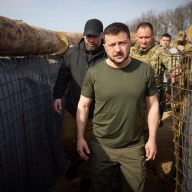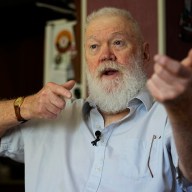LONGUEUIL, Que. – Some of Bob Thirsk’s mementoes in space are pure Canadiana.
The Canadian astronaut, who will spend the next six months on the International Space Station, will be able to look at a photo of Jean Beliveau signed by the former Montreal Canadiens great.
He can also read excerpts from “Anne of Green Gables” after packing a page of the Canadian literary classic. A spokeswoman for the Canadian Space Agency said the whole book was too heavy to accompany Thirsk.
Thirsk, speaking from the orbiting space lab on Monday, described Beliveau as a “class act” and a “role model.”
” If I’m going to stay calm and collected on this mission, he’s a good example for me to follow,” he told reporters during a news conference that was broadcast live at the space agency in Longueuil, just south of Montreal.
The 55-year-old Thirsk said he brought the “Anne of Green Gables” material in honour of Koichi Wakata, one of his fellow space travellers, and “our Japanese friends who are also big fans.”
Also included in his space baggage were several rings which were specially designed for his wife, two sons and daughter.
They include several elements of the official patch for Thirsk’s mission.
The native of New Westminster, B.C., appeared in awe as he answered questions from the back row along with his five fellow space travellers.
“Believe me, this is a surreal world here,” he said, without elaborating. “I sometimes feel I’m in the middle of a Salvador Dali painting here.”
Thirsk admitted he has a steep learning curve as he settles in for the six-month trip – a record stay in space for a Canadian astronaut.
“In one respect the space station looks similar to what I expected,” he said.
“The training simulators that we have in the various countries are very good and they give us some good background training.
“On the other hand, the place looks completely different from what I expected in that there’s a lot of stowage all over the place.”
Thirsk, who landed on the station Friday, said his greatest fear is making a serious blunder while his greatest challenge will be to improve his efficiency.
“You know astronauts always have fear of injury or death, but our greatest fear is of making a mistake so I just hope I can get through this six months without making any serious mistakes,” he added.
His arrival with Russia’s Roman Romanenko and Belgium’s Frank De Winne means there are six astronauts aboard the station for the first time in its 10-year history.
The trio blasted off on board a Soyuz spacecraft last Wednesday from the Baikonur cosmodrome in Kazakhstan.
It’s the first time a Canadian has travelled to the space station aboard a Russian Soyuz. In the past, American space shuttles were used to ferry Canadian astronauts up and down.
Thirsk said it was a smoother ride than his only other space mission, in 1996, when he flew as a payload specialist aboard the space shuttle Columbia.
“If you’re to think of the space shuttle as a powerful SUV, then Soyuz is a nimble sports car,” he said as his five colleagues gathered around.
“The ride was quite a bit smoother, I thought, than the shuttle. For the first two minutes of the shuttle flight it’s pretty bumpy, it’s impossible to read.
“But in the Soyuz it was smooth all the way up.”
Thirsk, a medical doctor, also outlined his routine, saying he gets up at 6 a.m. GMT for what turns into a busy day.
“It’s a steady pace but a lot gets accomplished,” he said.
During his time in space, Thirsk will participate in a York University experiment that will help people who have trouble telling up from down.
He will also operate a little rover-type vehicle nicknamed “Red” by remote control from space.
The robot, the size of a thick suitcase, is parked and waiting for his commands in a backlot of the Canadian Space Agency.
The six astronauts now on board will soon be joined by seven others, including Canadian Julie Payette, who is scheduled to blast off June 13 aboard the U.S. space shuttle Endeavour on a 16-day mission.
That will be the first time Canada has had two astronauts in space at the same time.
In an article in the most recent edition of the Canadian Medical Association Journal, Thirsk and other international space experts said the two main challenges associated with human space flight are radiation and the physiological consequences of living and working in a microgravity environment.
















